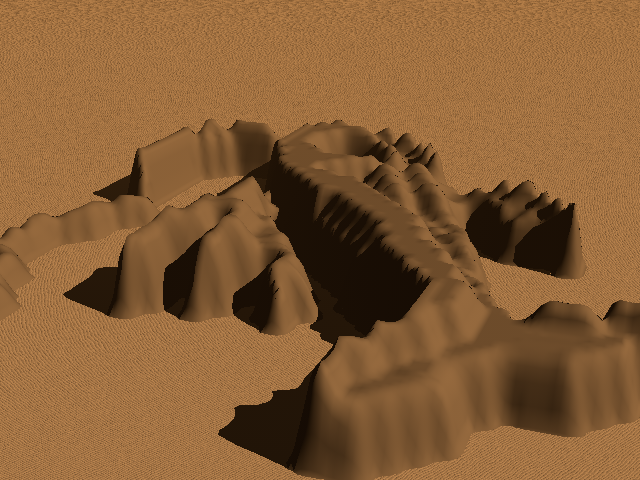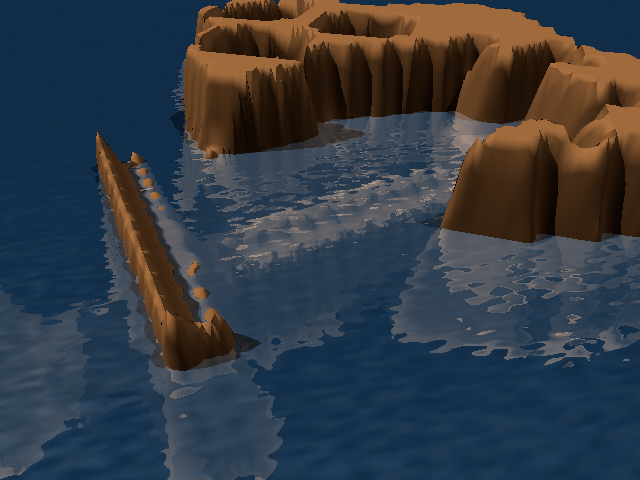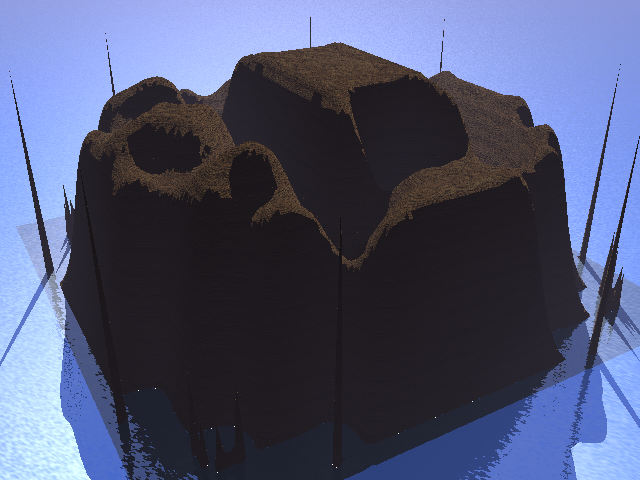Gielinor
I called my last RuneScape post “pseudo-penultimate,” but I may have gotten ahead of myself. This post picks up some threads from Defining Terms specifically and some ideas about Jaquaysing the world more generally, but should stand on its own.

“Gielinor” is the name of RuneScape’s world, like “Middle Earth” is the world of The Hobbit or “Azeroth” is the world of Warcraft. When thinking about RuneScape, I commonly think, “that’s Gielinor, but it’s not RuneScape.” It’s not important to me, for example, that a game has lava-people to be “like RuneScape.” I want to know why playing RuneScape feels like it does, not why it is what it is, so I usually abandon these ideas quickly.
But RuneScape’s gameplay is inextricable from its setting, in a way that isn’t always true of other RPGs. You can fight a beholder in any world with a “beyond,” and find a dragon of some color in any given biome. But you can’t play Risk on a Candyland board, at least without a lot of changes, and RuneScape feels more like that. You can make a different Risk board, of course, but the rules of the game make certain demands of it. How many armies can the licorice lands raise each turn? What borders the peppermint kingdoms?
So it’s worth considering what’s good about Gielinor, and maybe what’s not?

For most of my experience with RuneScape, Gielinor is in what’s known as the fifth age. (Don’t worry about the previous ones.) And in that age there are three gods:1 Saradomin, the god of good and light and purity; Zamorak, the god of evil and dark and ambition; and Guthix, the powerful neutral nature god who was woken up by their fighting and has now banned them from direct interference.2 This is not terribly original, but it is very useful.
A cold war is a tense set-up for anything, a two-ingredient powder keg. It demands every action declare its allegiance. It breeds paranoia and secrecy and conspiracy. This is all great for games.
Additionally, a cold war casts every action as important. You’re not just solving rat problems for private interests, you’re shoring up their efforts to pull ahead in the perpetual race. You can’t just protect a village from a demon, by doing so you’ve also branded yourself an ally of whatever ideology that village follows.
And cold wars breed innovation as well as paranoia. In the real world, the space race gave us all kinds of technology. In RuneScape, the war drives the Wizards’ Tower and the Zamorakian Magical Institute to rediscover lost magics and take dangerous risks with poorly-understood ideas. Funding is never an issue for the White Knights of Falador or the Vyrewatch of Morytania.

The many kingdoms of Gielinor, even the nominally allied ones, are isolated from each other by great walls, deep rivers, sparse expanses, vast oceans, and stranger barriers. This Balkanization serves multiple narrative purposes.
From a practical point of view, it lets Jagex work on discrete areas separately.3 Commonly, a new area is opened with an announcement that “we’ve repaired that bridge,” or “the city has opened its gates.” Similarly, building these barriers into the world could be a good way to optimize prep. A locked door in one session (if the players decide it’s not worth forcing) is an opportunity for players to return with the key later, but also after I’ve had time to fill in behind it.
Even once they’re open, these areas can take a long time to reach. Al Kharid is near Burgh de Rott on the map, but you’ll need to take a detour around the dig site, through some mountains, and under the temple at Paterdomus, only to arrive at the far end of the river Salve and trek back down through the ghast-infested Mort Myre swamp, the winding snail-paths outside the abandoned mine, and the shade-haunted village of Mort’ton. These artificial travel restrictions make room for optimization, but they also provide a “denser” experience per unit area. The length of the journey makes for an extended composition phase, and more opportunities for improvisation and distraction. At higher levels, you may unlock many shortcuts, teleports, and tunnels to shorten this trip, a kind of overland Jaquaysing, which also leads to emergent gameplay.
In terms of mood, these barriers add a sense of decline to the setting. West Ardougne is quarantined from East Ardougne. Burthorpers do not leave their fortified mountain home, for there are wolves to the South and trolls to the North. The gnome lands are divided in two by a maniacal warlord’s encampment and gladiatorial games. Even the monks of Entrana have cut themselves off from the world, retreating to an island they can more easily police.

Gielinor is unafraid to make concessions in the name of fun. I mentioned that the map is hopelessly contorted, but additionally it just doesn’t show things that aren’t important.4 Even though Falador has a population of ~80,000 people, there are only maybe 100 ever shown, and maybe a dozen named and detailed. Like the partitioned map, this optimization is similarly good for TTRPG prep. It’s classic GM advice, really, applied to game development.
This distorted scale also comes up in the running bits in RuneScape. Just as any long-running game will eventually develop its own in-jokes and shorthands, Gielinor feels lived-in. Why are cabbages so important? Who is Stankers up by the coal trucks? Almost everything in RuneScape is part of something else or serves some other purpose, but the things that don’t are what help the world stand out. Fortunately, I think this, too, is practical and simple to achieve in a TTRPG without any particular effort.
Once you’ve stripped out all the uninteresting parts of the map and all the unnecessary people, what’s left is a clear focus on the player character. Everyone knows you’re a hero, whatever associations that brings. They’ll give you quests and ask you for help, trust you and take advantage of your assumed good nature. You’ll never witness a mugging, but you might get mugged. You might even get put up to a mugging by some other ne’er-do-wells!
The only place this tight focus falls down is in its passive commitment to genre norms. Your hero comes from nowhere, has no past. When you die you go to Lumby. If you spend hours murdering guards, they’ve forgotten you tomorrow. Even in quests, you can end up locked in some unreasonable course of action, and with no GM to adjudicate, you just can’t have other options. It’s the wrong kind of crunch, but not because it’s unconsidered, it’s just locked to its medium. This is fine5, but I think not worth emulating in this project. (This tension is of course, part of what I was really interested in with The Uncanny Hinterlands.)

I say “passive commitment” because RuneScape has a gleeful disregard for internal consistency and originality. Priority one is getting to the screen (or table, in our case), and it takes advantage of any pre-made content, common cultural references, and memetic duplications that it can. In the same way that a GM might describe an NPC in relation to a well-known actor, RuneScape will give them a winking name. Like a GM might import a whole megadungeon to their hexcrawl, Jagex has dropped literal Camelot in the middle of Kandarin.
The integration of these disparate components is secondary, because it’s practically assured by the act of play. It’s hardly surprising to see Romeo in Varrock square because he has a quest for you. Juliet’s house is across the street from Gertrude’s, and her father hosts elaborate holiday parties there. If you’ve got a particularly difficult mystery, you may need to seek out Sherlock Holmes, wandering shirtless North of the Legend’s guild.
A layer removed from broader culture, Old School RuneScape even takes and develops ideas from its own community, effectively mirroring the RPG tradition of letting players do the heavy lifting.
The result, of course, is absurd, inconsistent, and ahistoric. Unexamined, it can even begin to lean on harmful stereotypes. But it does match closely with my experience of D&D (and other games) as they are played. Take what shortcuts you can, and the players (or the act of play) will smooth out the edges. Step back from the patchwork you’ve assembled and see that it’s really a quilt.

In conclusion, Gielinor is a land of contrasts
While the map of Gielinor has many high-level desirable traits for a game, I think most of these were hit upon accidentally. This gives me hope that the best parts can still be reproduced while working in a prep-optimized (or production-optimized) fashion. These usefully lazy shortcuts include:
- a strongly motivating framework (in this case a cold war),
- siloed areas of development and a complex map,
- prioritizing the functionality (“game-ness”) of the world,
- and relentless pillaging of its cultural context.
And all of these practices are already common or at least easy to implement in a tabletop game.

Illustrations
The images in this post are various images fromRuneScape imported into Geomorph as height maps and rendered as landscapes. The very spiky ones result from the shrinking of full world maps to an acceptable size, while the smaller, smoother ones are icons distorted into a square shape.

Other gods exist, but are not worshiped openly. Don’t @ me about Zaros or Icthlarin or whoever.↩︎
As with most of these types of story, a magical nuke was involved and “the wilderness” is the scar it left behind. I’m not sure this ingredient is critical to the formulation, but it’s resonant, perhaps for real-world reasons.↩︎
This also has the side-effect of creating entertainingly blocky regions.↩︎
In RuneScape lore, this discrepancy is called scale theory, and I hate it. But I like what it gets us in practical terms.↩︎
These artificialities also create a rich optimization environment. BITD, it was common practice to bank all your gear, turn-off auto-retaliate, and pick a fight with some large local fauna for the “free teleport.”↩︎